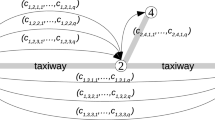Abstract
Two conflict graph based concurrent transmission scheduling algorithms are proposed in this paper to efficiently solve the spatial TDMA (STDMA) scheduling problem for the next generation WLAN. Firstly, the STDMA scheduling problem for multiple timeslots is formulated as an multiple-step optimization problem. Secondly, a bi-weighted conflict graph is constructed to model the concurrent transmissions’ interference relationships, where the nodes denote the transmission request and the weights of the edges denote the interference level between any two transmission request nodes. If the interference between two transmission nodes is larger than the given interference threshold, then there are no edge between these two nodes. And only the acceptable interferences are modelled as the edges. Finally, a heuristic clique based algorithm (HCBA) and an optimal clique based algorithm (OCBA) are proposed, where HCBA assigns the transmission requests to the multiple timeslots one by one while OCBA assigns the transmission requests to the multiple timeslot once. The performance gap between the optimal one and the suboptimal one is evaluated. Simulation results show that HCBA not only has low complexity but also achieves similar performance comparing to OCBA.









Similar content being viewed by others
Notes
Similar terms are defined in IEEE 802.11ay [4], where the superframe is a beacon interval (BI). In each BI, there exists one data transmission interval (DTI), which is consisted by zero or more contention based access period (CBAP) and several service period (SP). CBAP is scheduled by AP where any STA can access the channel based on EDCA, and SP is negotiated between AP and STA or dynamically allocated where STDMA scheduling algorithms can be applied. This is named as spatial sharing mechanism in IEEE 802.11ay [4].
References
Cisco (2019) Global mobile data traffic forecast update, Cisco Visual Networking Index: White Paper, Cisco, Tech. Report
Ericsson (2019) The power of 5G is here and will continue to spread across the globe in the coming years. Ericsson Mobility, Tech. Report
IEEE 802.11ax Task Group (2019) IEEE P802.11ax d4.0 telecommunications and information exchange between systems local and metropolitan area networks specific requirements. IEEE, pp 1–746
Zhou P, Cheng K, Han X, Fang X, Fang Y, et al (2018) IEEE 802.11ay based mmWave WLAN: design challenges and solutions. IEEE Commun Surv Tutor 20(3):1654–1681
IEEE 802.11be Task Group (2019) Project authorization request, Part 11: wireless LAN medium access control (MAC) and physical layer (PHY) specifications amendment: enhancements for extremely high throughput (EHT). IEEE, pp 1–2
Li B, Qu Q, Yan Z, Yang M (2015) Survey on OFDMA based MAC protocols for the next generation WLAN. In: 2015 IEEE wireless communications and networking conference workshops (WCNCW), pp 131–135
Cai LX, Cai L, Shen X, Mark JW (2010) REX: a randomized exclusive region based scheduling scheme for mmWave WPANs with directional antenna. IEEE Trans Wireless Commun 9(1):113–121
Taya A, Nishio T, Morikura M, Yamamoto K (2019) Concurrent transmission scheduling for perceptual data sharing in mmWave vehicular networks. IEICE Trans 102-D(5):952–962
Zhang J, Lai H, Xiong Y (2019) Concurrent transmission based on distributed scheduling for underwater acoustic networks. Sensors 19(8):1871–1879
Sum CS, Lan Z, Funada R, Wang J, Baykas T, Rahman M, Harada H (2009) Virtual time-slot allocation scheme for throughput enhancement in a millimeter-wave multi-Gbps WPAN system. IEEE J Sel Areas Commun 27(8):1379–1389
Cai R, Chen Q, Peng X, Liu D (2013) Spatial sharing algorithm in mmWave WPANs with interference sense beamforming mechanism. In: IEEE military communications conference (MILCOM), pp 163–168
Yan Z, Li B, Zuo X, Yang M (2015) A heuristic clique based STDMA scheduling algorithm for spatial concurrent transmission in mmWave networks. In: IEEE wireless communications and networking conference (WCNC 2015), pp 1036–1041
Sum CS, Harada H (2012) Scalable heuristic STDMA scheduling scheme for practical multi-Gbps millimeter-wave WPAN and WLAN systems. IEEE Trans Wireless Commun 11(7):2658–2669
Qiao J, Cai LX, Shen X, Mark JW (2012) STDMA-based scheduling algorithm for concurrent transmissions in directional millimeter wave networks. In: IEEE international conference on communications (ICC 2012), pp 5221–5225
Cheng MX, Ye Q, Cai L (2015) Rate-adaptive concurrent transmission scheduling schemes for WPANs with directional antennas. IEEE Trans Veh Technol 64(9):4113–4123
Rakesh RT, Das G, Debarati S (2018) Energy efficient scheduling for concurrent transmission in millimeter wave WPANs. IEEE Trans Mob Comput 17(12):2789–2803
Lakshmi LR, Sikdar B (2018) Fair scheduling of concurrent transmissions in directional antenna based WPANs/WLANs. In: IEEE international conference on communications (ICC 2018), pp 1–6
Toyoda I, Seki T, Iiguse K (2006) Reference antenna model with side lobe for TG3c evaluation. IEEE document, 802.15–06
Maltsev A (2010) Channel Models for 60 GHz WLAN Systems. IEEE document, 802.11-09/0334r8 ed
Pisinger D (2005) Where are the hard knapsack problems?. Comp Oper Res 32:2271–2284
Östergård PRJ (2002) A fast algorithm for the maximum clique problem. Dis Appl Math 120(1):197–207
Author information
Authors and Affiliations
Corresponding author
Additional information
Publisher’s Note
Springer Nature remains neutral with regard to jurisdictional claims in published maps and institutional affiliations.
This work was supported by the National Natural Science Foundations of China (No. 61771392).
Rights and permissions
About this article
Cite this article
Yan, Z. Conflict Graph Based Concurrent Transmission Scheduling Algorithms for the Next Generation WLAN. Mobile Netw Appl 25, 1873–1885 (2020). https://doi.org/10.1007/s11036-020-01569-5
Published:
Issue Date:
DOI: https://doi.org/10.1007/s11036-020-01569-5




